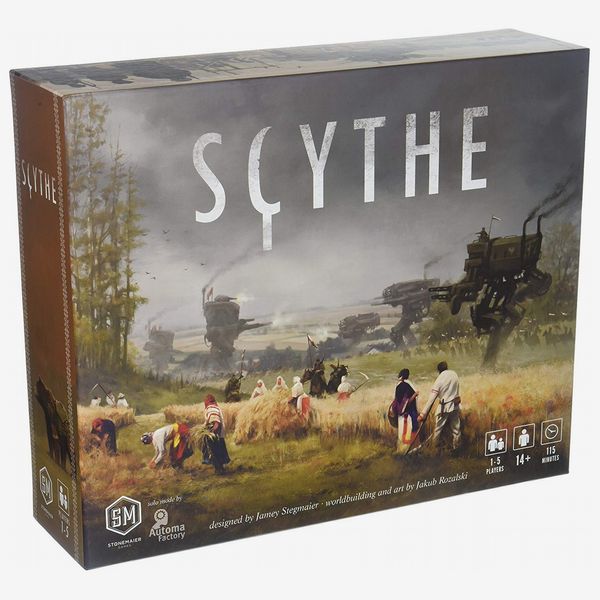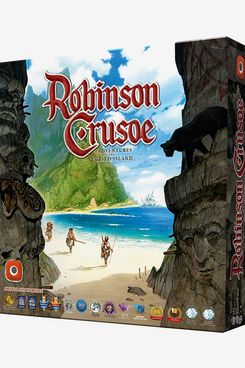
Families have nearly endless options for game night, including four-player board games, while couples have many choices for two. But for those who live alone, it might feel like you have to wait until you have friends over. Liz Davidson, who has been reviewing solo games on her site Beyond Solitaire and on Dice Tower since 2016, says that one-player games are actually a very popular gaming category: Board Game Geek’s guild that’s devoted to the subject has more than 19,000 members, and the Solo Board Gamers Facebook group, which Davidson calls “a very friendly place to go if you want to talk solo board games,” has more than 56,000 members. In recent years, Davidson says she’s also noticed more and more game publishers introducing solo modes to their offerings so they can be played by individuals or in a group. So we talked to Davidson and four other gamers about the best solo games, from crime-solving to escape rooms to city-building.
One-Player Games for Beginners
If you are looking for a quick and super-easy game, Davidson says, Orchard is fast and can take as little as ten minutes to play. “It’s just a really cute little card game where you overlap different types of fruit trees and try to overlap enough that you get high scores,” she explains. And even though you can get through it quickly, you can play over and over again. In fact, you can play twice after dealing just once: “It’s actually an 18-card game where you have one deck of nine cards you play, and then you can immediately pick up the other half of the cards and play a second time.”
Friday is what’s called “a deck building game where you start with a certain deck of cards and you add and subtract cards as you go to get rid of cards that are less powerful, and gain cards that are more powerful,” Davidson explains. In this specific deck-building game you’re trying to build a collection of cards to make Robinson strong enough to defeat the pirates on your island, but some of the cards in the deck will set you back on that goal. “You have to really cull your deck to get that bad cards out of it,” Davidson says. “And it can be really, really challenging because you have to take hits to your own health in the game,” but in a fun way apparently that keeps you coming back for more since she says “a lot of people will play over and over and over trying to crack that system.”
Onirim is part of the Oniverse series, which comes recommended by Davidson and the American Tabletop Awards committee. Davidson describes the series as a bunch of little games that are “all set in the same world, and they all work a little differently, but they’re all relatively simple, affordable games that are for one or two people.” This one specifically is “a really meditative card game that is about being trapped in a labyrinth of dreams. You’re trying to find the doors to get out, but some cards are nightmare cards that force you to give things up that you found and you’re trying to reach your goals before you run out of cards,” she says. And while Davidson warns that the app version of some board games are disappointing, Onirim’s phone equivalent is not only good but sometimes free.
Eric Yurko, an American Tabletop Awards committee member and game reviewer for his own site, What’s Eric Playing?, calls this one of his all-time favorite games, and Davidson recommends it too. “This 18-card game may not seem like much, but it’s an excellent execution of a simple concept,” says Yurko. You are trying to build a city with the goal of getting the highest score. “On the front of each card is a two-by-two-inch grid of districts with some roads, and on the back of each card is a scoring condition,” Yurko says. “You reveal three scoring cards and use the remaining 15 to build up a city. With other players, you’re passing the cards you don’t use once your turn ends; by yourself, you’re just trying to beat the target score and win.” What makes it particularly interesting for solo gaming is your score target will be different every time you play, so it won’t get repetitive. Davidson also finds that “for a tiny game, it is incredibly frustrating and puzzle-y, but that’s what makes it fun.” (Plus it can be played by up to four players, when you can spend time with friends and family again.)
If you’re looking for a “quick, snappy” game that’s easy to learn but “still has a bit of substance to it,” Yurko suggests Cascadia, where the goal of the game is to create a Pacific Northwest ecosystem. Yurko has one word to sum up the work of game designer Randy Flynn: “exceptional.”
While Yurko recommends the entire Exit series, he thinks The Forgotten Island is a good title for beginners. “They essentially encapsulate the escape-room experience and make it playable at home with only a pair of scissors and some paper and pens for notes,” he says. In this one, you will have to solve riddles to escape and island. The only caveat this series of games comes with is that you will run out of games to play: “Each one can only be played once, and lasts about two hours, but there are currently 15 plus available Stateside,” Yurko says.
Most phone games are solo games, but if you prefer digital gaming, Davidson recommends this one because it’s relatively affordable, especially when some solo-gaming apps can near $50 apiece. It’s also really fun. “Basically, you are trying to get the tokens in your bag to be the right configuration to brew a really good cup of coffee,” which sounds simple, but Davidson still calls it “weirdly addictive.” As she explains, “You’re trying not to let your beans burn, but you’re also trying to get bad stuff out of the bag. If you roast for too long, smoke ends up in there and you have to make a decision about ‘When do I perform a cup test so I’m not gonna pull all the bad tokens that I have accrued throughout the game?’” On top of that, it has a helpful tutorial and is easy to learn.
One game that is kind of a bridge between solo gaming and the digital world is Railroad Ink. It can be played solo, but if you are quarantined alone, or just have a long-distance friend, Yurko says, it works well over video chat. “This fantastic little train game has you rolling dice to add roads and rails to your board to build up a train and highway network,” he explains. Playing solo, you are just trying to see how high of a score you can get, and it is also easy to take on the road and is quick to play, so there’s no getting bored. If you do play virtually, the other person just needs to print a copy of the boards, and “one player rolls the dice, and the other players record them. Highest score wins.”
Something at the more challenging end of beginner games is Welcome To, where players act as ’50s suburban planners trying to build three neighborhoods. “To do so, you’ll number houses every round to try and have them in increasing order, left to right,” Yurko says. “The complex part is deciding what other features of your neighborhood should be added. Where do you build fences? Should you put in pools? What about a park? Balancing all this to try and get the highest-scoring neighborhood is very challenging.” Gameplay gets even more complex when you introduce more players, though Yurko says he’s “been in games of this with over a hundred people before, so I can say for certain that it can handle that.” And if you’re gaming digitally, Welcome To was also recommended by George Georgeadis of Oniro Games as a good Zoom game; one person must own the game to display the cards, and everyone else just needs a pencil and a score sheet, which they can download and print for free here or download a free app onto their phones for a digital version.
“If you’re playing with kids, a really good game that can be played solo or cooperatively with pretty much anyone is Castle Panic,” says Davidson. “You are in a castle, and there are monsters coming through the woods, and they’re trying to overthrow your castle, so you have cards you can play to try to knock them out before they come and knock your stuff over.” What makes it easy for kids is that you can help them play, as it’s also a cooperative game. “People can trade cards, look at each other’s hands, try to come up with a plan for how to succeed.” Davidson describes the game art as cartoony and points out that the rule book is very simple and easy to read.
Advanced One-Player Games
“Fans of Risk should definitely give Scythe a try because of its fantastical art and beautiful miniatures,” says Greg May, owner of the Uncommons and Hex & Company. Scythe takes place in a post-WWI dystopia where players have to vie for resources and land. Since the rules are dense and the gameplay is long, it’s a good option for more advanced players who have hours to spare.
Board-game designer Rob Sparks calls this “one of the all-time greatest survival board games” in which you can “play as the fabled Robinson Crusoe as he and his crew become shipwrecked on a cursed island and must explore, hunt, shelter, and hopefully escape the island before it’s too late.” While Sparks notes that there are a lot of rules that make the game more difficult to pick up, he says the payoff is well worth the effort to learn. “What you’ll find is a dynamic and tense game that will have you cheering at every lucky card draw and dreading everything else,” he says. “It’s utterly brilliant.”
This solo game has the added challenge of playing against someone — even if that someone is just another deck of cards. “If you’re the only one who wants to play a game, a lot of games will actually include a little AI deck to help you play by yourself or maybe hone your skills if somebody in your household is a little better than you are at the game,” says Davidson. Wingspan, which won American Tabletop Awards’ Best Strategy Game for 2020, is one of those games. Davidson explains, “Wingspan comes with a set of solitaire playing cards where you play and then you also keep score and compete against the score of an opponent who is directed by just a very simple deck of cards.” The goal here is to get the best birds into your wildlife preserve and end up with the most points.
Chronicles of Crime was the 2019 winner in the American Tabletop Awards’ Strategy category. As the name suggests, it’s a crime-solving game, but “to do so, you have to use your phone to scan cards and gather clues before finding the culprit, which is a lot of fun,” Yurko explains. “Add in some VR-style gameplay to figure out clues at some scenes of the crime, and you’ve got a nice technological upgrade for a solid board game.”
If you don’t always play alone, Spirit Island might be a good game to have on hand, because it’s easy to play in a group. “It is a game where you are all spirits who are trying to get colonizers to leave an island and leave you and the native people who live there alone,” Davidson says. “So what’s really interesting is that you start out not as powerful as you will be later in the game, and meanwhile, the people who are invading the island are very strong. So you have to very carefully figure out what you’re going to do to manage the crisis till you get strong enough to actually do something about it.” Played with multiple people, Davidson says, “you have to really cooperate, because a person’s spirit cards will help everyone else,” but if played solo, you can just control multiple spirits.
Another more challenging pick from Yurko is Cartographers, in which players become mapmakers in a made-up world. “Each round, you draw cards and detail out your map, but monsters can occasionally attack and cause you to lose points,” he explains. “Playing solo, you have to follow some rules to add monsters to your map. You follow the same rules if you’re playing with other people and they’re not in the room with you.” In other words, you can play this over video chat too — but be sure you have good Wi-Fi, because this can be a long game.
According to Davidson, this is “the best solo game of all time,” but it’s probably also the hardest game on our list. “It’s a game where you play this very powerful character who can fight and do magic that basically goes through the countryside, powering up and conquering cities.” Which more plainly means “you’re doing a lot of really complicated movement and combat and powering up all with one deck of cards.” This makes it hard, but that’s also why people love it so much. “One of the things people like about Mage Knight is that it’s hard, so if you’re gonna play the same game over and over and over, it will be a different game every time it kind of unravels,” Davidson says. And because it’s difficult, it takes a long time. She says, “Some people leave the game set up on their table and come back over the course of days.”
One-Player Card Games
We said no solitaire, and we’re sticking to that, but there are other card games that can be played with just a traditional deck of cards. “Pretty much any game you can play with one person is technically a solitaire game, but the wealth of game styles, games played, games strategies is so diverse,” says Scott McNeely, author of Ultimate Book of Card Games: The Comprehensive Guide to More Than 350 Games. Klondike is the proper name for the seven-pile card game that comes to mind when people say solitaire — which McNeely admits is pretty boring — but there are lots of variations of games that can be played with a simple deck of cards that are far more interesting. Hands is a game that can literally be played in one hand. Games like Forty Thieves and Crazy Quilt require two decks to play. Then there’s Clock, which is a solo card game so challenging that McNeely himself has never won it. You can learn exactly how to play each of these games and hundreds of others in the Ultimate Book of Card Games (or by doing a Google search).
Additional reporting by Jenna Milliner-Waddell
The Strategist is designed to surface the most useful, expert recommendations for things to buy across the vast e-commerce landscape. Some of our latest conquests include the best acne treatments, rolling luggage, pillows for side sleepers, natural anxiety remedies, and bath towels. We update links when possible, but note that deals can expire and all prices are subject to change.
























